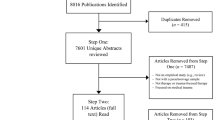Abstract
Experimental studies have documented the development of posttraumatic stress disorder (PTSD) in first responders. These studies have routinely included police, firefighters, and paramedics. However, there is another group of first responders that are at risk for PTSD but that has received less research attention. This group is comprised of coroners. This paper reviewed the published data concerning coroners and PTSD and outlined various treatments for addressing coronial PTSD. The findings, the differing treatments, and a detailed methodological inquiry are presented. The need for a conceptual framework for the various other professional groups responding to critical incidents and a crisis intervention approach to address the psychological needs of both family survivors and coronial personnel are noted.
Similar content being viewed by others
References
Flannery RB Jr. Treating psychological trauma in first responders: a multi-modal paradigm. Psychiatry Q. 2015;86:261–7.
Jacobowitz W. PTSD in psychiatric nurses and other mental health care providers: a review of the literature. Issues Ment Health Nurs. 2013;34:787–95.
Milner A, Witt K, Maheen H, LaMontagne AD. Suicide among emergency and protective service workers: a retrospective morality study in Australia, 2001-2012. Work. 2017;57:281–7.
Surgenor LJ, Snell DL, Dorahy MJ, et al. Posttraumatic stress symptoms in police staff 12-18 months after the Canterbury earthquake. J Trauma Stress. 2015;28:162–6.
Skogstad M, Skorstand A, Lie A, et al. Work-related post-traumatic stress disorder. Occup Med. 2013;63:175–82.
Gray SE, Collie A. The nature and burden of occupational injury among first responder occupations: a retrosepctive cohort study in Australian workers. Injury. 2017;48:2470–7.
Crawford KA, Flannery RB Jr. Critical incident stress management and the Office of the Chief Medical Examiner: preliminary inquiry. Int J Emerg Ment Health. 2002;4:93–7.
Wright RJ, Peters CP, Flannery RB Jr. Victim indentification and family support in mass casualties: the Massachusetts model. Int J Emerg Ment Health. 1999;1:237–42.
Flannery RB Jr. Posttraumatic Stresss disorder: the victim’s guide to healing and recovery. 2nd ed. American Mental Health Foundation: New York; 2012.
Brondolo E, Wellington R, Brondolo E, Brondolo TJ, Delahanty D. Work-related predictors of psychological distress among mendical examiner personnel. Acad Forensic Pathol. 2012;2:80–91.
Coleman JA, Delahanty DL, Schwartz J, Murani K, Brondolo E. The moderating impact of interacting with distressed families of decedants on trauma exposure in medical examiner personnel. Psychol Trauma. 2016;8:668–75.
Brondolo E, Eftekharzadeh P, Clifton C, et al. Work-related trauma, alienation, and postraumatic and depressive symptoms in medical examiner personnel. Psychol Trauma. 2017;9:1–9.
Brondolo E, Wellinton R, Brady N, et al. Mechanisms and strategies for prventing post-traumatic stress disorder in forensic workers responding to mass fatality incidents. J Forensic Legal Med. 2008;15:78–88.
Tait G, Carpenter B, Quadrelli C, et al. Decision-making in a death invenstigation. Jounral of law and. Medicine. 2016;23:571–81.
Trabsky M, Baron P. Negotiating grief and trauma in coronial jurisdictions. J Law Med. 2016;23:582–94.
Witt K, Milner A, Allisey A, Davenport L, LaMontagne AD. Effectiveness of suicide prevention programs for emergency and protective service employeees: a systematic review and meta-analysis. Am J Ind Med. 2017;60:394–407.
Brondolo E, Kaur A, Brondolo T, et al. Developmenmt of a web-based scalable intervention to reduce metnal health risks in medical examiner personnel. TPM. 2017;24:409–21.
Jareo I, Artigas L, Luber M. The EMDR protocol for recent critical incidents: Aplications in a disaster mental health continuum of care context. J EMDR Pract Res. 2011;5:82–94.
Author information
Authors and Affiliations
Corresponding author
Ethics declarations
Conflicts of Interest
The corresponding author, writing on behalf of both authors, states that there are no potential conflicts of interest of any kind in this submission to Psychiatric Quarterly.
Human and Animal Studies
This review of published findings involved no direct research for this manuscript that involved human or animal participants.
Informed Consent
Thus, there was no need for an IRB review or informed consent.
Rights and permissions
About this article
Cite this article
Flannery, R.B., Greenhalgh, T. Coroners and PTSD: Treatment Implications. Psychiatr Q 89, 765–770 (2018). https://doi.org/10.1007/s11126-018-9580-9
Published:
Issue Date:
DOI: https://doi.org/10.1007/s11126-018-9580-9




